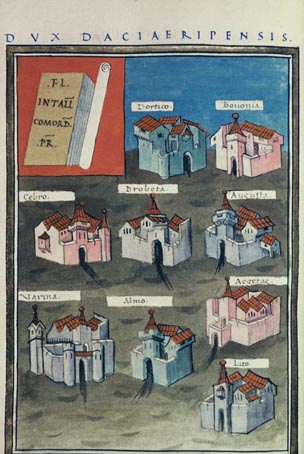
This page last modified: 30 December 2014 (Maier reference numbers added)

 Above: Frontpiece from the Bodleian manuscript. The stations depicted are: Dortico, Bononia, Cebro, Drobeta, Augusta, Varina, Almo, Aegetae, Lito. |
The following cavalry units or detachments of units are listed as being under the command of the Duke of riverine Dacia (i.e. north Bulgaria; the numbers beside the names refer to Ingo Maier's numbering scheme):
80.2 Cuneus equitum Dalmatarum Fortensium, at Bononia along with these Auxiliares units or detachments of units:
80.12 Auxilium Miliarentium, at Transalba and the following prefects and tribunes and their legionary units:
80.20 Praefectus legionis quintae Macedonicae, at Variniana |
The men under the Praefectus militum exploratorum are listed in the auxiliary heading (80.11), but given they are commanded by a Prefect; they would appear to have been misplaced from under the legionary heading (80.19). The men under the Praefectus classis Ratianensis would appear to be stationed at Ratiaria (near modern Archar in Vidin, Bulgaria). The unit is not given a name in the Notitia; it is undoubtably another detachment of the Classis Histricae ("Danubian fleet").
The men under the various Praefecti legionis quintae Macedonicae are clearly (part of) the old Legio V Macedonica Pia tris Fidelis tris, long stationed at Oescus (modern Gigen in Bulgaria); one of the above detachments (80.22) is still recorded as being at Oesco. Further detachments of this legion are found under the Magister Militum per Orientem and under the Comes limitis Aegypti.
The men under the Praefectus legionis tertiaedecimae geminae are (part of) Legio XIII Gemina, which was stationed at Ratiaria (near modern Archar in Vidin, Bulgaria) after Aurelius withdrew from Dacia, and which was the capital of Daciae ripensis; one of the above detachments (80.27) is still recorded as being there in the Notitia. Further detachments of this legion are found under the Magister Militum per Thracias and the Comes limitis Aegypti. Inscriptional evidence referring to a PRAEPOSITUS COHORTIS II RED[...] found at Sostra (modern Lomec in the Czech Republic) would seem to indicated that the "Siosta" recorded in the Notitia refers to Sostra, and thus is not a current garrison location name; i.e. the unit is from Sostra, and not at Sostra. See Florian Matei-Popescu; The Roman Army in Moeisia Inferior; National Museum of Romanian History, Centre for Roman Military Studies, 7; Eds O. Tentea, F. Matei-Popescu, Conphys, Bucharest (2010), p 228, available here.
For some reason I used to think the Auxilium Crispitienses was named after Crispus, Constantine the Great's eldest son, who was executed in 326 AD (probably because A.H.M. Jones thought the similarly-named Equites Crispianorum under the Dux Britanniarum was "certainly" named after him). But clearly they are named after the place they are stationed at: Crispitia! Perhaps Crispus was born there.
The shield patterns of the detachments of the Thirteenth and the Fifth, under the Magister Militum per Thracias and the Magister Militum per Orientem, respectively, are given below; those under O come from the Bodleian manuscript in Oxford, those under P from the Paris manuscript, those under M from the first portion of the Munich manuscript, those under W from the second portion of the Munich manuscript, and those under B from the Froben edition (which, being printed, reverses the facings of the designs).

These are unlikely to be the same as those borne by the detachments still under the Dux Daciae however. That of the Thirteenth in particular is clearly related to three seemingly otherwise unrelated units under the Magister Militum per Thracias and could have been adopted when these four units all joined that command, presumably simultaneously.

Return to the Notitia index page.